This blog looks at how Policy Lab’s latest ‘Government as a System’ (GaaS) toolkit can be used to map the COVID-19 response as well as a few other ways that public service innovation teams can support policymakers in their response and recovery from the global pandemic.
In my last blog I shared our new ‘Government as a System’ toolkit for action on complex issues that cross local, central and international contexts, which I recently explained in a talk at the 2020 Canadian Policy Comm conference. We also tested it in London at the ‘top 200’ Policy Excellence Group in February to look at collective action on climate change. So a month later, it felt a natural next step to see if this toolkit might also offer some insight on COVID-19.
Needless to say it's been a very busy few weeks as we’ve moved the entire Policy Lab team to focus on COVID-19. This shift has also enabled us to think about how we might apply our specialist skills in design, ethnography, futures, innovation and policy to support policymakers across government at this crucial time.
Looking to the future
Every policymaker, strategist, delivery team, service provider and public servant will be speculating on what the future now holds for their individual areas of responsibility. In Policy Lab we think that policy innovation teams can help bring a fresh perspective to the COVID-19 response in three ways:
- Future policy scenarios - anticipating, exploring and communicating future policy scenarios to enable future strategy to pivot between different possible futures as the emerging picture requires.
- New data for new times - generating and bringing in new data, establishing an effective evidence base for the future (including ethnographic ‘thick data’).
- Whole system leadership - providing expertise and tools for systems leaders to rapidly convert strategy to coordinated action through a network of people and platforms (using new tools like the Government as a System toolkit).
Creating future policy scenarios
Over the last six years Policy Lab has delivered many policy projects that explore new paradigms in uncertain times by building possible future policy scenarios. In these projects we have trialled different tools, including speculative design, to help policymakers consider what might come next. The OECD’s (Organisation for Economic Co-operation and Development) Observatory of Public Service Innovation are calling this anticipatory innovation.
The futures cone (adapted from Voros, 2003, below) shows that the future is made up of not just what we expect will happen - the probable, but what could possibly happen. It is designed to challenge thinking and asks people to consider which future is preferable?
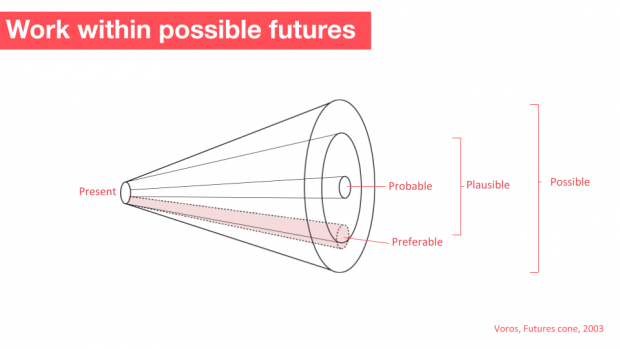
As the government responds to Covid-19, it’s preferred styles of action are changing. Ideas previously considered unthinkable, like social distancing, are becoming policies the public accept - expanding what is referred to as the 'Overton Window'. So the preferable futures people may consider today could be more divergent and more radical than before.
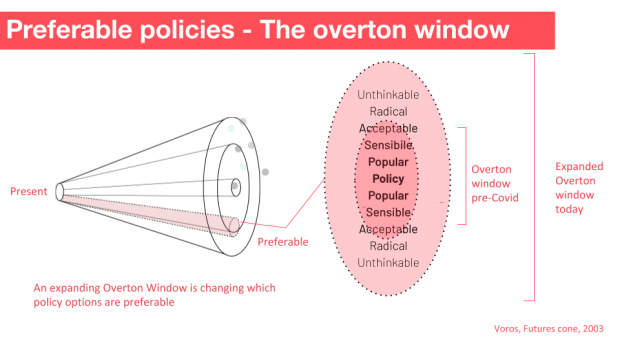
New data for new times
Policy Lab researchers are rapidly developing more real-time approaches to data collection, using tools such as lean and prescriptive analytics, paired with behavioural insights, ethnography to give the ‘thick data’ of people’s lived experience. We are also using ethnography to understand how different communities and cultures are affected by some of the new rules such as social distancing.
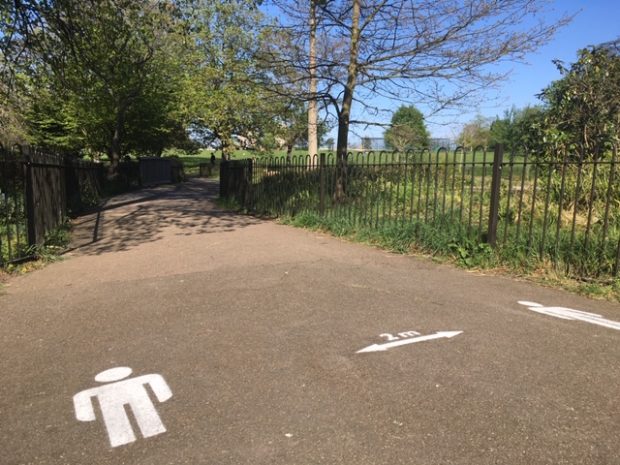
We shouldn’t assume that the world that emerges after the pandemic will reflect the one we left behind. Every policymaker, strategist, delivery team, service provider and public servant will be speculating on what the future holds for their individual areas of responsibility. For COVID-19 the ability to adjust to the emerging data picture is important. Whilst good policy interventions need to be evidence-based and informed by data, it is likely that some of our baseline research, analytics and data assumptions will need re-assessing. Owing to the speed at which change is happening and the lag time between data collection and policymaking, some metrics will have lost some of their value, worst still others could be misleading, contributing to false certainties. Thinking carefully about this new baseline data will be important.
Data needs are also likely to change. Using Policy Lab’s Analytics Ladder (adapted from Gartner) we have mapped data tools that can be used at different points in policymaking.
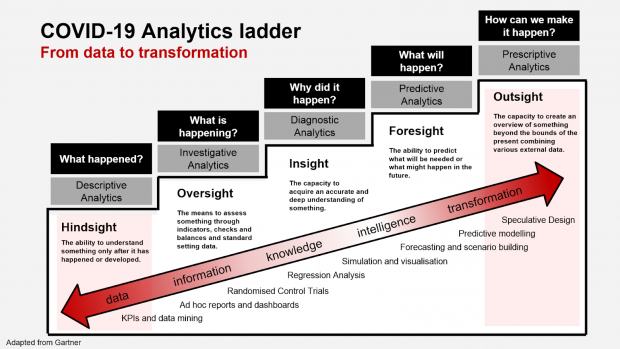
Real-time 'oversight' from data analysis (towards the left of the diagram) has been a crucial metric for tracking COVID-19 cases. However, after this initial response the focus of policy is likely to move from knowledge and intelligence (in the middle of the diagram), towards data for reflection and transformation (at the edges of the diagram). This will require more lean analytics and new tools such as ethnography, speculative design and data mining to gain fresh insights into people's lived experiences.
Whole system leadership - Tentatively mapping COVID-19 government actions
Countries around the world are using different forms of power to tackle the novel coronavirus at pace. This effort requires whole system leadership to rapidly convert strategy into coordinated action at local, central and international levels. So how might applying new tools like the Government as a System bring new insight?
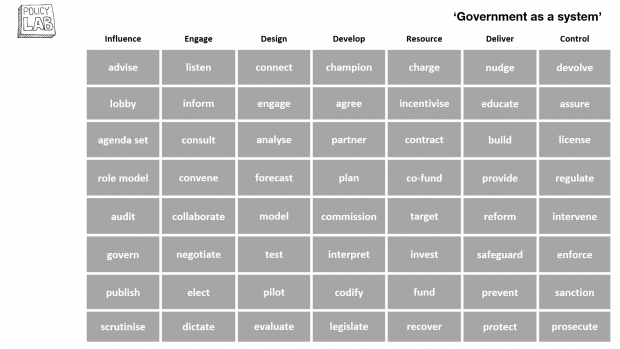
The tool maps different forms of action available to governments, divided into seven categories. These categories range from powers of control (towards the right hand side) that we often associate with authorities such as licensing, regulating, assurance and enforcement, to different forms of influence (towards the left hand side) such as advising, agenda setting, role modelling and scrutinising. We developed the tool to help different groups across the public, private and social sectors to better understand government as a system, whilst also fostering greater collaboration across local, central and international contexts. The tool can support policymakers to actively reflect on the levers currently being used and presents possible alternatives for consideration.
As the COVID-19 pandemic response is emergent, the combination of policy levers used is likely to change over time, perhaps ultimately using all of a government’s powers in due course. The animation below shows one speculation of how the current powers and policy levers might change over time. This is provisional, rather a demonstration highlighting different government actions as the COVID-19 situation emerged.

As we develop the tool we will be testing and refining the language. We know it isn’t right yet as it will need applying in many different contexts before we can really generalise. For now we think it might be useful to share this as work in progress so others can also collaborate with us on it.
Over the coming weeks and months, we will be applying a range of other innovative policymaking tools with a focus on COVID-19. This is a fast-paced, complex and emerging situation, and our team in Policy Lab is ready to help the government’s policymakers at this unprecedented time. If you would like to work with us, please do get in touch: policylab@cabinetoffice.gov.uk.
2 comments
Comment by Joseph Voros posted on
Hello. Try this updated version of the Futures Cone - that one is two decades old now.
https://thevoroscope.com/2017/02/24/the-futures-cone-use-and-history/
Cheers,
JV
Comment by Iain MacLeod posted on
I like the COVID- 19 analytics ladder....and...I wonder how we could develop the model to go beyond the cliff edge. The bidirectional arrow does not quite do it for me. How about a double helix, incorporating Argyris and double loop learning? Just a thought!